Statistics Release: Adults with Learning Disabilities Implementation of 'Same as You?' Scotland 2007
To present the fifth set of National figures for services provided for adults with learning disabilities.
Introduction
The purpose of this Statistics Release is to present the fifth set of national figures for services provided by local authorities in Scotland for adults with learning disabilities. All figures for 2007 relate to the week ending 16 September 2007 and are provisional. As such, they may be subject to change. The final figures will be published in future publications.
This publication is a result of The same as you? review of services for people with learning disabilities, published in May 2000. Its 29 recommendations for developing learning disability services set out a programme for change over 10 years.
Main Points
- 16 per cent of adults with learning disabilities were in employment and 42 per cent of these were in open employment.
- A third of all adults with learning disabilities lived in their own tenancy.
- 28 per cent of adults with learning disabilities attended day centres and 27 per cent had some form of alternative day opportunity
- A local area co-ordinator service was in use in 29 local authorities, compared to 14 in 2003.
- 32% of all adults with learning disabilities known to local authorities had a personal life plan.
Chart 1: Percentage of Adults with Learning Disabilities living in their own tenancies,
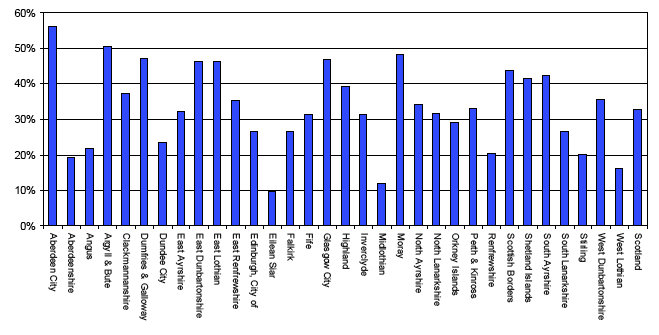
Section 1: Adults Known to Local Authorities
In September 2007 an estimated 22,875 adults with learning disabilities were known to local authorities across Scotland (see table 1). This corresponds to approximately 5.5 adults with learning disabilities per 1,000 population and ranged from 3.4 in Perth & Kinross to 9.8 in Midlothian. Ratios for all local authorities can be found in annex A where they are given alongside an age and gender split for each local authority.
Table 1: Adults with learning disabilities known to Local Authorities, 2007
No. Adults |
Male |
Female |
Total |
% of Total |
Rate per 1,000 pop'n |
|---|---|---|---|---|---|
16-17 |
491 |
274 |
765 |
3% |
6.0 |
18-20 |
1,131 |
696 |
1,827 |
8% |
8.9 |
21-34 |
3,812 |
2,596 |
6,408 |
28% |
7.1 |
35-49 |
3,990 |
2,992 |
6,982 |
31% |
6.0 |
50-64 |
2,621 |
2,210 |
4,831 |
21% |
5.0 |
65+ |
1,004 |
1,058 |
2,062 |
9% |
2.5 |
Total |
13,049 |
9,826 |
22,875 |
100% |
5.5 |
Source: Same as You? annual survey 2007
The majority of adults with learning disabilities, 57 per cent of those known, were male. 31 per cent were aged between 35 and 49, this equates to 6 per 1,000 population in that age group. The 1,827 18-20 year olds represented 8.9 people per 1,000 population in that age group.
Section 2: Local Area Co-ordination
One of the recommendations of The same as you?' was that local authorities and health boards should put in place local area co-ordinators to get to know people with learning disabilities and their families, assist them to identify their needs and help them to get their needs met.
An estimated 2,961 adults benefited from the services of a local area co-ordinator across 29 local authorities providing the service in Scotland. This equates to an estimated 13 per cent of all adults with learning disabilities known across Scotland. Chart 2 shows the change in availability and use of the service over time.
Chart 2: Availability and use of Local Area Co-ordination, 2003-2007
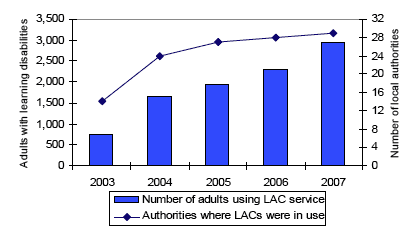
Around 82 per cent of adults receiving this service were aged between 21 and 64. This corresponds to 13 per cent of all adults in this age group and compares to 14 per cent of all adults aged between 16 and 20 and 8 per cent of those aged 65 or over ( Annex B).
The proportion of adults in receipt of this service varied amongst the local authorities providing it from one per cent in 2 local authorities to 51 per cent in Moray and 96 per cent in Aberdeen City. Annex B provides a breakdown by local authority.
Section 3: Personal Life Plans/Person Centred Plans
A Personal Life Plan ( PLP) is a process for continual listening and learning which, in alliance with a person's family and friends, focuses and acts upon what is important to someone now and in the future. The same as you? recommends that everyone with a learning disability who wants a PLP should be able to have one.
A total of 7,402 adults with learning disabilities had a personal life plan. This is around a third of all adults known across Scotland.
Over the years a number of Local Authorities have reported improved collection of this data which explains some of the increase in these figures.
There is some variation in the level of take-up between authorities, the highest being East Dunbartonshire where 68 per cent of adults known to the council had a personal life plan. A full breakdown of PLPs by Local Authority can be found in annex C.
PLPs were most common amongst the 21-64 age group. An estimated 35 per cent of all adults in this age group had a PLP compared to 18 per cent of 16-20 year olds and 27 per cent of those aged 65 or over ( Annex C).
Chart 3: Number of people with a PLP, by age group, 2003-2007
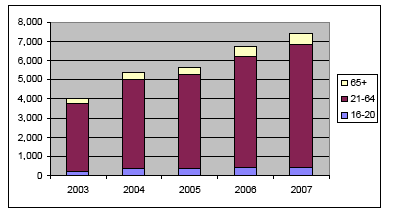
Section 4: Independent Advocacy Service
An independent advocate is someone who gets to know a person with learning disabilities and helps them to speak up for themselves.
An estimated 2,756 adults, 12% of all those known to local authorities, had an independent advocate. This represents an increase of nearly 300 people since 2006.
The highest take up of Independent Advocacy was in East Ayrshire where 60 per cent of adults with learning disabilities received the service. Figures from 2003 to 2007 can be found in annex D for all local authorities.
Chart 4: Independent Advocacy Service, by age group, 2003-2007
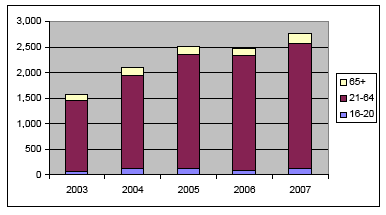
13 per cent of all 21-64 year olds had an independent advocate. The corresponding figure was lower for other age groups with 5 per cent of 16-20 year olds and 10 per cent of those aged 65 and over receiving the service ( Annex D).
Section 5: Employment Opportunities
One of the recommendations of The same as you? states that greater priority needs to be given to developing a range of employment opportunities for people with learning disabilities. This is seen as being important in helping people to be included in society.
Chart 5: Adults with learning disabilities, by type of employment, 2007
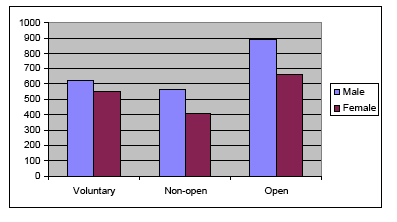
In a typical week there were 3,699 adults with learning disabilities engaged in some sort of employment throughout Scotland. This figure corresponds to 16 per cent of all known adults with learning disabilities.
Around 42 per cent of the 3,699 were in open employment. This corresponds to roughly 7 per cent of all adults with learning disabilities. (Definitions of employment types can be found in annex E along with figures showing the numbers of adults with learning disabilities in employment by local authority).
Section 6: Further Education
In a typical term-time week, 4,594 adults with learning disabilities were in some form of further education.
Table 2: Adults with learning disabilities in Further Education, 2007
16-20 |
21-64 |
65+ |
Total |
|
|---|---|---|---|---|
Male |
663 |
1,755 |
37 |
2,455 |
Female |
468 |
1,620 |
51 |
2,139 |
Total |
1,131 |
3,375 |
88 |
4,594 |
Source: 'The Same As You?' annual survey - 2007
This represents an increase of over 500 people compared to 2006. The participation rate varied between age groups. Around 44 per cent of all 16-20 year olds with learning disabilities were in some form of further education.
Annex F provides a breakdown of further education figures by local authority.
Section 7: Training
Adults with learning disabilities receive a variety of employment training opportunities outwith further education colleges.
In the six months leading up to September 2007, a total of 1,642 adults with learning disabilities, an estimated 7 per cent of all known across Scotland, received some form of training ( Annex G).
A local authority breakdown of the number of adults with learning disabilities receiving training opportunities can be found in annex G.
Section 8: Community Short Breaks
A community short break is where a break is provided in a non-residential setting for the carer and the person with the learning disability.
In a typical week in Scotland an estimated 1,935 adults with learning disabilities had some form of community short break. This is 8 per cent of all adults with learning disabilities known across Scotland. The level of use of community short breaks varied between local authorities with the highest levels in Dumfries & Galloway (28 per cent of all known adults with learning disabilities) and Argyll & Bute (33 per cent). Figures for all local authorities can be found in annex H.
Across Scotland, an estimated 9 per cent of 16-20 year olds had community short breaks as well as 9 per cent of 21-64 year olds and 4 per cent of those aged 65 or over ( Annex H).
Chart 6: Percentage of people receiving a community short break, by age group, 2003-2007
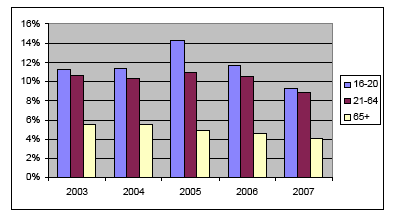
Section 9: Adults Living in their Own Tenancies
Throughout Scotland, 7,497 adults with learning disabilities were living in their own tenancies or were owner occupiers. This is an increase of over a thousand people from the 2006 level. The figure represents a third of all adults with learning disabilities and includes 7 per cent of all 16-20 year olds ( Annex I).
The numbers and percentages of adults living in their own tenancies are shown for each local authority in annex I and chart 1 on the front page.
Chart 7: Adults living in their own tenancies, by age group, 2003-2007
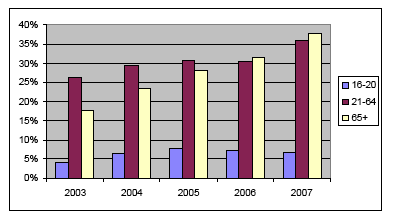
Section 10: Alternatives to Traditional Day Services
The same as you? says that the role of day centres should change. Nobody should go to a day centre full-time but they should instead get alternative day opportunities for at least part of the week.
Annex J shows the number of adults attending a day centre in Scotland in a typical week along with those receiving alternative opportunities.
An estimated 6,343 adults with learning disabilities attended a day centre in Scotland in a typical week. This corresponds to a quarter of all adults with learning disabilities known across Scotland. The number of adults attending day centres has dropped for the fourth year running as has the percentage of all adults known to the Local Authority. Chart 8, below, illustrates this.
Chart 8: Adults attending day centres, 2003-2007
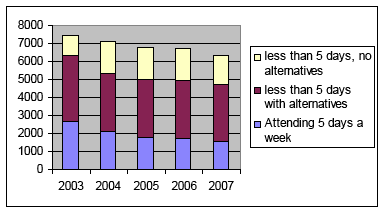
The Same As You?
Understanding these Statistics.
Data was collected with respect to the week ending 16 September 2007, although some local authorities provided information for a different week, which was thought to be more typical.
The same as you? signalled a fundamental change in the way services were provided for adults with learning disabilities. Increasingly services are no longer focussed on buildings, whether in a hospital or Day Centre. People with learning disabilities are now living in the community, often with their own tenancy in a house or small group accommodation. New style day services are being introduced, with a focus on people, and a variety of things to do. More people with learning disabilities are doing activities during the day that are stimulating and include them in the community.
Following the publication of the first set of national figures for services provided by local authorities in Scotland for adults with learning disabilities, a consultation was held with local authorities. As a result of this a number of the questions asked of local authorities were altered slightly and additional guidance included for the 2004 survey. At the same time data collection methods have improved significantly with each publication and, consequently, care should be taken when comparing the figures over time.
Local Authorities were asked to provide information on the number of adults with learning disabilities known to them, what their living arrangements were and what services were provided for them.
A full or partial return was received from 30 out of the 32 Local Authorities in Scotland. Perth & Kinross and Eilean Siar did not return the 2007 survey and figures are based on the 2006 survey. Argyll & Bute figures were not of a sufficient quality for publication and 2006 figures have been used. For certain topics a small amount of information has had to be estimated for some Local Authorities.
Local Authorities continue to improve their data collection and recording practices. In some cases fluctuations in figures for individual local authorities on a year-on-year basis are due, at least in part, to these improvements rather than to actual changes in the level of a service being provided. Where this is known to be the case a footnote has been included in the relevant annex.
Care should also be taken when comparing the number of adults receiving a particular service as a proportion of those known to local authorities. In some cases the calculation may not be based on the same base of individuals. Therefore in general those figures should be treated as estimates.
All of the local authorities and their NHS and independent sector partners are making progress implementing The same as you? Any comparisons between authorities should take account of local prioritisation and varying baseline levels of service.
Figures relating to 2007 are provisional. The final figures will be published in future publications.
Further Information
The Statistics Release is available on the Internet by accessing the Scottish Executive web site: www.scotland.gov.uk/Topics/Statistics/Browse/Health/Publications
Further information on adults with learning disabilities is available from our website at: www.scotland.gov.uk/Topics/Statistics/Browse/Health/Data/LearningDisabilities
Further details and analysis of the data presented in this Statistics Release are available on request from the address given below.
Community Care StatisticsBasement Rear
St Andrew's House
Edinburgh
EH1 3DG
Contact: Steven Gillespie
Tel: 0131 244 3777
E-mail: SWStat@scotland.gsi.gov.uk
This statistics release was published on 25 March 2008.
There is a problem
Thanks for your feedback